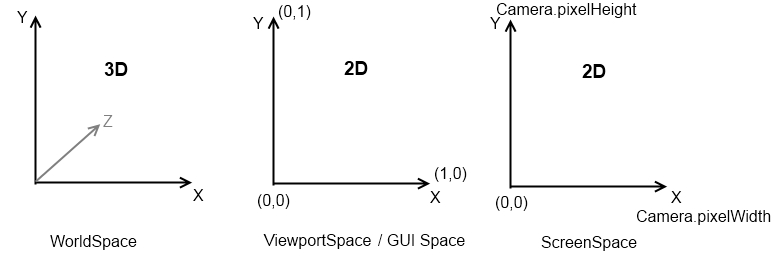- Home /
About World space and Local space
when I use several sample codes, I usually meet those ScreenToWorldPoint, WorldToScreenPoint, InverseTransformDirection etc...
these used many areas : camera or mouse move code. and descriptions of these are convert space : from screen to local, from local to world or from world to local etc...
But I don't know that difference and why I should use it.
plz teach me.. T.T
Answer by flamy · May 24, 2012 at 10:26 AM
Unity uses 3 different co-ordinate systems, World point system, Screen point system and view-port point system. These functions are used to find where the particular point will be in another point system.
To be clear, when you are giving a mouse input or touch input, it will be in screen point system. which has only x and y. to use this inside the game and set it to a particular object ( snap an object to mouse) takes certain work, you have to consider camera position, rotation, object depth and stuffs, ScreenToWorldPoint function makes the developer's work simple. it converts the point to world co-ordinate jus by taking mouse position and z depth.
view port is the space to which the camera renders. sometime you can get the area occupied by an object on the view port and used it like a button(just an example), in case of orthographic it will be easy. In this care you have to convert the world point to and from viewport point. so you need to use WorldToViewportPoint and it alias function.
the image i have attached would show why the conversion is must link text
Your drawing about Screenspace is wrong: bottom-left is (0,0). Just attach this code to a GameObject:
using UnityEngine;
using System.Collections;
public class example : $$anonymous$$onoBehaviour {
void OnDrawGizmos() {
Vector3 p = Camera.main.camera.ScreenToWorldPoint(new Vector3(0,0, Camera.main.camera.nearClipPlane));
Gizmos.color = Color.yellow;
Gizmos.DrawSphere(p, 0.1F);
}
}

Answer by Wolfram · May 24, 2012 at 10:23 AM
Local vs. world space: http://answers.unity3d.com/questions/31169/explanation-local-vs-global-space.html
Screen vs. world space: here is an example: http://answers.unity3d.com/questions/14404/create-an-object-in-screen-space-coordinate.html
A really short overview:
World Space: the absolute XYZ coordinates of all objects
Local Space: relative coordinates, in relation to a reference object. For example within an object hierarchy, the Transforms of all children are local to their parent
Screen space: an essentially twodimensional space, used to place objects directly at certain absolute pixel positions on your screen
The methods you found are used to convert from one coordinate representation to another. For example, convert the x/y position of a mouse to a direction from the camera position into the world space of the scene.
Also, google a bit for these keywords, you will find plenty of tutorials and explanations of each coordinate space.
The third bulleted point really confuses me as I read that the values of screen space range from -1 to 1. If that is true then how can it be used "to place objects directly at certain absolute pixel positions on your screen."?
@tokyodan: what you mean is Viewport Space, see @janoonk's picture above. Screenspace uses pixels: http://docs.unity3d.com/Documentation/ScriptReference/Camera.ScreenToWorldPoint.html
Answer by lilinjie_ · Sep 09, 2017 at 03:15 PM
// You can try this in Unity to see the value of Screen Space point, View Space point
// and World Sapce point.
using System.Collections;
using System.Collections.Generic;
using UnityEngine;
public class Test : MonoBehaviour
{
/*
* A screen space point is defined in pixels. The bottom-left of the screen
* is ( 0, 0 ); the right-top is ( pixelWidth, pixelHeight ). The z position
* is in world units from the camera.
*
* A viewport space point is normalized and relative to the Camera. The
* bottom-left of the Camera is ( 0, 0 ); the top-right is ( 1, 1 ). The z
* position is in world unity from the camera.
*
* A world space point is defined in global coordinates(for example,
* Transform.position).
*
* There are a visual show:
* http://blog.projectmw.net/unitys-screen-point-viewport-point-and-world-point
*
* Local Space VS World Space:
* http://answers.unity3d.com/questions/31169/explanation-local-vs-global-space.html
*
* Reference:
* https://docs.unity3d.com/ScriptReference/Camera.html
*/
void OnGUI()
{
Camera c = Camera.main;
Event e = Event.current;
Vector2 mousePos = new Vector2();
// Get mouse position in Screen space point
mousePos.x = e.mousePosition.x;
// The e.mousePosition.y is reverse
mousePos.y = c.pixelHeight - e.mousePosition.y;
Vector3 screenPoint = new Vector3( mousePos.x, mousePos.y, c.nearClipPlane );
// View space point's z is the c.nearClipPlane
Vector3 viewPoint = c.ScreenToViewportPoint( screenPoint );
// When the Camera's rotation equal Vector3.zero, the World Space point's
// z is the c.transform.z + c.nearClipPlane
Vector3 worldPoint = c.ScreenToWorldPoint( screenPoint );
GUILayout.BeginArea( new Rect( 20, 20, 300, 120 ) );
GUILayout.Label( "Screen pixels: " + c.pixelWidth + ":" + c.pixelHeight );
GUILayout.Label( "Screen position: " + mousePos.ToString( "F2" ) );
GUILayout.Label( "Viewpoint position: " + viewPoint.ToString( "F2" ) );
GUILayout.Label( "World position: " + worldPoint.ToString( "F2" ) );
GUILayout.EndArea();
}
}
Answer by Danze3 · May 24, 2012 at 11:02 AM
World Space is the XYZ on the main World, which you see in the upper right corner of the screen.
Local Space refers to the Objects XYZ which is entirely different with the World XYZ
if you use Rigidbody's XYZ, it will use Local Space. If you use the Transform, it will use the World Space.
If still unsure, I can redirect you to the Video Explanation.
Uhm, the Transdorm inspector shows always the local space coordinates (.localPosition), even when you switch the local / global. A Rigidbody on the other hand is always simulated in worldspace.
Your answer

